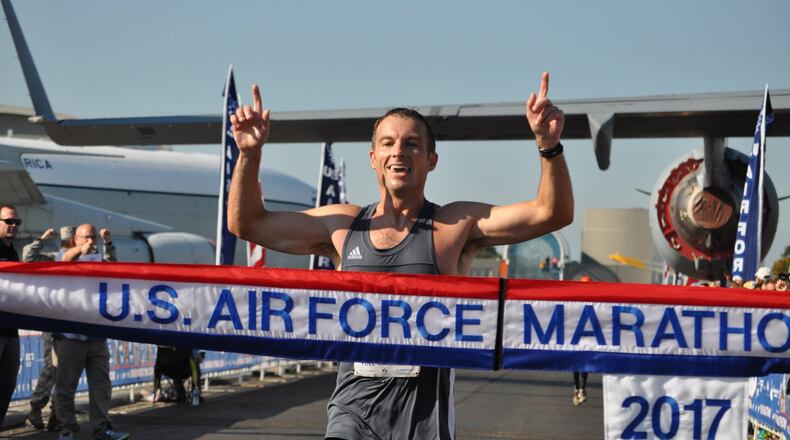The marathon counted 13,679 runners for the races on Sept.15-16 versus more than 15,000 who competed every year since 2012 — reaching a peak of 15,424 runners in 2013, figures show. The last time the race did not sell out was 2009 when the event had a cap of 10,000 runners and fell a few dozen under that total.
Organizers will listen to what runners say they want before deciding what to do, he said.
“We don’t want to make change just for changes sake,” he said.
RELATED: Thousands to run in Air Force Marathon
The 5K and 10K races sold out this year, but the numbers for the half- and full-marathons were below previous years, according to attendance figures. The half marathon brought in just over 5,200 out of a target of 6,500; the full marathon attracted about 2,100 out of a goal of 2,500, according to race figures.
Still, the race brought competitors from all 50 states and 14 countries to the Miami Valley event, Aguiar said. The marathon has raised caps on the number of runners by thousands since the first race attracted 2,751 participants in 1997.
And it’s big business for the region. The race had an estimated $13.7 million economic impact on tourism and travel-related spending in 2016, according to the Greene County Convention & Visitors Bureau. Figures for this year’s marathon weren’t yet calculated.
A ‘saturation’ of races
Race industry observers say the U.S. market has reached “saturation” with a sharp uptick in the number of races while the number of runners crossing the finish line has dropped nationwide.
“This is not just an Air Force Marathon issue,” Aguiar said. “It is a racing industry issue. There’s a lot of races out there.”
The industry had 30,400 races in the United States last year versus 26,370 in 2012, according to Running USA statistics. More than half the contests in 2016 were 5K competitions.
The number of finishers climbed exponentially —- from five million in 1990 to a peak of 19 million in 2013. Since then, it’s fallen to just under 17 million, Running USA reported.
RELATED: FIve things to know about the Air Force Marathon
The explosion in the number of races has been pushed mostly by 5K contests with themes, such as costumes, bubble, or foam races, holiday and charity runs, among newcomers, according to Running USA Chief Executive Officer Rich Harshbarger.
“They’re more celebration and more social than they are competitive,” he said. “People started coming up with crazy ideas.
”The real question is what’s the longevity of some of those and I think a lot of them are running their course, so to speak,” he added.
The popularity of mud and cross-fit competitions have waded into the scene, too, he said.
“There’s a lot of things vying for people’s recreation time and particularly when you’re looking at the millennial generation they’re looking for something with a little bit more edge than a straightforward run,” Harshbarger said.
RELATED: Stealth fighter, WWII plane to fly over Air Force Marathon
On weekends in the southwest Ohio region, runners have found a bevy of races to choose.
“People want to try all kinds of different things and when they have more choices they are more choosy about what they participate in,” said Doug Picard, 37, who has run in each of the Air Force Marathon’s four contests since 2014.
Surveying for answers
The marathon will survey runners in the coming weeks, listen to feedback gathered elsewhere such as social media and email, and explore how races across the country engage runners, Aguiar said.
“We’re all looking at that making sure … any changes that we do that it’s always a positive experience for the runner,” Aguiar said.
RELATED: Thousands turn out for Air Force Marathon, winners announced
Racers input led to the addition of a 10K race and dropping a relay marathon nearly a decade ago, he said.
Picard, a member of the Ohio River Road Runners Club in Dayton, has competed in 100 contests. Races retain runners with different strategies, such as recognizing people who compete in more than one race at an event, or give out a piece of a racing medal every year until its complete, he said.
“It keeps people coming back year after year,” he said.
Harshbarger had this advice: “I think the best thing they can do is stay true to their brand and continue to offer an extraordinary experience,” he said. “As long as you highlight what’s uniquely yours and build on that to appeal to people, that’s better than any sort of gimmick or one-time trick. They are an established event.”
At the finish line
The number of races in the United States has climbed for years even as the number of runners reaching the finish line has dropped in recent years. The number of runners dropped from 19 million in 2013 to just under 17 million last year, the fourth largest in history, according to Running USA
Number of races
2016 - 30,400
2015 - 30,300
2014 - 28,000
2013 - 28,200
2012 - 26,370
SOURCE: RUNNING USA
About the Author
